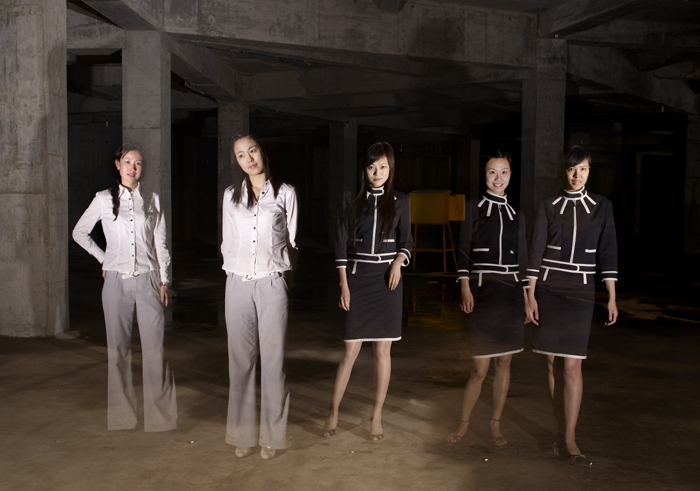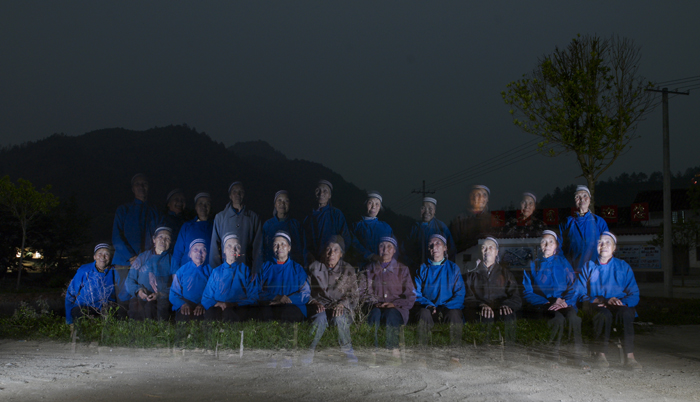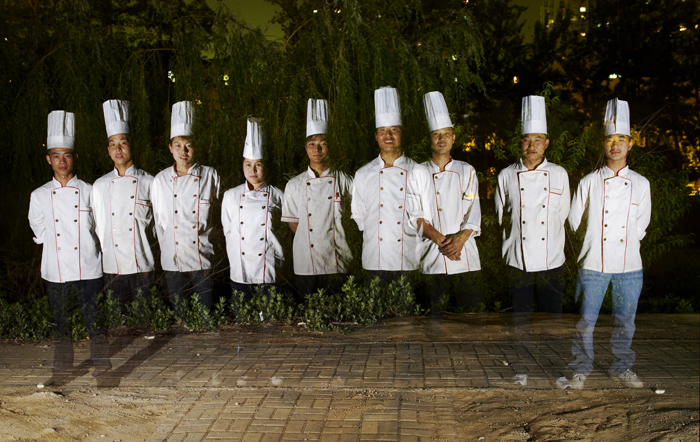Group Photo Series - Qiu Zhi Jie, Five Revolutionary Seconds - Sam Taylor-Wood
When I first saw Qiu's group photo series at the gallery, I wondered, "How did he take photographs like that? What was the meaning of the photographs? Why did he take those photographs? What was he trying to tell people?" The group photo series consists of 13 photographs in total. The photographs had dark backgrounds while the people seen in the photos were hit with light. The people looked like "ghostly figures", slightly translucent. The work was produced between 2006 and 2007 in different parts of China.
In Qiu's group photo series, it is also like a drama. In the video installation, it can be seen that, firstly, in the dark, a man walks to the front of the camera lens; stand up, the light lights on his body. He walks away. Then, the second person walks to the front of the camera lens too, standing beside the man who had just left. The light lights on his body. He walks away. One by one, the people walk onto the stage, stay for a while, and walk back. In the video, it shows a lonely person, appearing on the stage. Sometimes the man who is supposed to leave the stage may forget to leave. And sometimes, the man who is supposed to go onto the stage may not have arrived. Well the reason is, these people have received light and their form is kept, which becomes a group photo. Then, the group photo becomes a 'drama'. In the eyes of the audience, things that had happened in the same scene but in the different time are reconstructed in the same time and same space. Everyone in the photograph is related to each other. In the photo, the people appear together in the same group photo. Whereas in the video, they are actually very lonely themselves.
On the wall text next to Qiu's group photo series at the gallery, it was written that events happen at different times, but when seeing the photograph, they are relocated to the same time-space. The static photograph becomes a set of play an the relationship between one and the other is thus developed. Individuals appear as a group in the photographs ('we'), while the video shows them as solitary ('I'). In the photographs, there are collective narratives, names and identities of the individuals, but the video separates these identification.
In the video, the people are on of the "I-s", an individual. In the photograph, they are interpreted as "we", a group of people. They are a collective of narrative, a collective name and identity in the photography. However, the identity has been peeled off by the video. In the video, people return to the place which has no relation to others, people "escape" from the collective position. They are always neglecting the "I" but being aware of the "we". And when they think of "I", they often forget that "I" actually belongs to "we", a group of people. People are used to ignoring "I" when they consider the "we" and when they think about the "I" they forget that individuals unconsciously belong to a group.
The group photo series highlights the invisible relationship between people and it tells me that it takes up "I-s" to make up a "we".
Next, let me move on to another contemporary artist's work, Five Revolutionary Seconds by Sam Taylor-Wood. The reason why the art work is named as Five Revolutionary Seconds, is because it combines elements of the still and moving image and it is taken by a rotating camera that turns nearly 360 degrees in five seconds. The work records the motions and gestures of six actors and friends enlisted by Sam Taylor-Wood.
In the photograph, each character seems to be lost in his or her own reality. They look bored. Everyone in the photograph seems to be in their own world, thinking about their own problems in life. It can be told from their facial expressions and their body language. They are only thinking about themselves alone, and ignoring the people around them. They are all withdrawn, thus unaware of the people around them, the things happening near to them and their surroundings. They are acting as individuals in the photograph. In my opinion, I feel that they are selfish people who only care for themselves and not realizing that others are also in the same state as they are.
From Qiu's group photo series, it shows that certain people has neglected the importance of "I-s" and themselves. They have forgotten the fact that the individuals are very important to a group as they belong to it.
On the other hand, from Sam Taylor-Wood's photographs, it tells me how the other group of people who are selfish. They only have thoughts for themselves and their problems. They live in the world of their own and only think about their own problems in life. They have not realized that everyone around them, near to them, is exactly like themselves. They only bother about themselves without understand others around them.
I feel that both of the contemporary artists' photographs show the different types of "invisible relationship" between people, however, in a different and unique manner.
Photo credits:
http://www.moma.org/interactives/exhibitions/1998/newphoto14/sam_taylor_wood.html




No comments:
Post a Comment